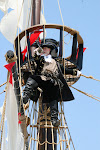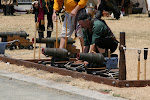“When Drake returned to Plymouth, the provisioning of his ships was virtually completed. He had left James Stydye, one of the captains who had served with him in Ireland in charge of lading the vessels. In addition to the pieces and equipage of the four prefabricated pinnaces, there were carpenter’s stores for their assembly and for the repair of the Pelican herself, including extra spars, timbers, and planks; kegs of tar, pitch, and rosin; and spare anchors, canvas and cordage as well as a portable blacksmith’s forge accompanied by quantities of iron bars and plate and a supply of charcoal. Also, for construction of fortifications and other works on land, there were a large number of axes, machetes picks, and spades. All these had to be fitted into the Pelican’s hold along with three tons of gunpowder and shot, sufficient water storage in casks to sustain the ship’s company for sixty days, and as much food as could be carried.
For victuals, Stydye had acquired the usual staples: biscuit, meal, pickled or dried beef, pork, and codfish; cheese, butter, rice, dried peas, raisins, salt, vinegar, sweet oil, mustard, honey, and numerous casks of wine and beer. Meals were cooked over a fire lit in an iron firebox, for which purpose quantities of firewood also had to be carried.
Then came the racks of arms and armor and a long list of miscellania, including lanterns, candles, buckets, fishnets, twine, hooks, needles, and cloth, shoes, bedding, plates, bowls, and tankards.“
from The Secret Voyage of Sir Francis Drake 1577-1580 by Samuel Bawlf






No comments:
Post a Comment